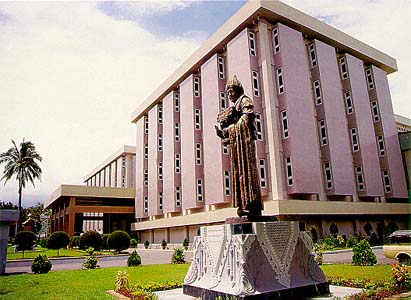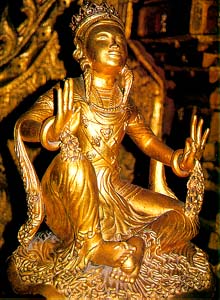Admin
Admin

Number of posts : 81
Localisation : New Delhi
Registration date : 2007-03-22
 |  Subject: National Museum ( Yangon ) Subject: National Museum ( Yangon )  Sat Sep 12, 2009 6:41 pm Sat Sep 12, 2009 6:41 pm | |
|  National MuseumThe National Museum of Myanmar is located at No. 66/74, Pyay Road, Dagon Township, Yangon, Myanmar. The National Museum of Myanmar was founded in 1952 with its premises at what was once the Jubilee Hall. In 1970 the museum was moved to a more spacious building on Pansodan Street. But these premises were not originally constructed to house a museum. The present National Museum is located on Pyay Road in a splendid five-storey building constructed for the purpose in spacious and specially landscaped grounds. Priceless ancient artifacts, works of art and historic memorabilia are on display in 14 halls on four storeys. Three halls on the ground floor hold exhibits on the evolution the Myanmar script and alphabet, the Lion Throne Room and Yatanabon Period pieces. National MuseumThe National Museum of Myanmar is located at No. 66/74, Pyay Road, Dagon Township, Yangon, Myanmar. The National Museum of Myanmar was founded in 1952 with its premises at what was once the Jubilee Hall. In 1970 the museum was moved to a more spacious building on Pansodan Street. But these premises were not originally constructed to house a museum. The present National Museum is located on Pyay Road in a splendid five-storey building constructed for the purpose in spacious and specially landscaped grounds. Priceless ancient artifacts, works of art and historic memorabilia are on display in 14 halls on four storeys. Three halls on the ground floor hold exhibits on the evolution the Myanmar script and alphabet, the Lion Throne Room and Yatanabon Period pieces.
Ground Floor One can study the origins of the Myanmar alphabet, Myanmar script and literature as well as those of the other national races of Myanmar. There is also an interesting stone funerary urn of the period AD1 - AD 9 with Pyu writings on it in this hall.
In the throne room you will see miniature models of the eight kinds of thrones of ancient Myanmar kings and the magnificent Royal Lion Throne of our last monarch King Thibaw in all its original majesty. This great throne is made of smooth-grained "Yamanay" timber adorned with lions at its base. The whole throne is heavily gilded. This throne is always placed in the "Hluttaw" Hall, (the Hall of the Council of Ministers). The king uses this throne when deliberating with his ministers on state affairs or delivering judgments on important issues.
In the 19th century Yadanabon Period Exhibit hall one can see clothing fashions, furniture and other household articles of the time. There is also a palanquin used by king Thibaw's Chief monk. It has a gilded roof with three spires.

First Floor
On the first floor of the museum are four halls, one with an impressive display of the royal regalia, a second hall with exhibits of historic significance; the third hall with exhibits of pre-historic times and the fourth containing exhibits on natural history. In the hall of the royal regalia one can see beautifully ornamented objects that played a significant role in important royal ceremonies of ancient kings throughout Myanmar history. An example of the high standard of craftsmanship is the royal betel box in the shape of a Brahminy (Hamsa) bird. It is a beautifully gilded box embedded with valuable gems.
In the hall of Myanmar history are the pagodas, temples, monasteries and ordination halls of the Bagan Period and the marvelous murals of the Pinya, Innwa, Toungoo, Nyaungyan and Konbaung Eras. One can see rare ancient votive tablets with moldings from scenes of the Jataka Stories, that is the Lord Buddha's birth stories.
In the hall of pre-historic times is a model of the Padalin Cave which is over 10,000 years old where stone age men once dwelt and etched drawings on its walls. There are also stone weapons of the Neolithic Period and also some bronze weapons of a later age. Then, there are clay pots, urns, votive tablets and necklaces that date back to the Pyu Era that spans the period from the first century to the ninth century A.D.
Then there are rare and priceless exhibits - silver chedis (stupas) found in the archaeological excavations at the ancient Pyu city of Sriksetra. They provide material evidence that Buddhism had flourished in Myanmar as far back as the ancient Pyu Period.
In the exhibit hall on natural history are many fossils dating back millions of years. In this hall is an exhibit that is a truly rare find. It is fossil of an anthropoid primate that has been dated as being approximately 40 million years old. It was found in the Pondaung region of Upper Myanmar.
Second Floor
The second floor of the museum is where exhibits on Myanmar culture can be seen with one hall assigned to Myanmar music, song and dance.
In the hall on culture are displayed exhibits on Myanmar rural life. One can learn much of the social, economic and cultural traditions as well as modes of transportation of days gone by. One sees the Myanmar bullock cart still in use in some rural areas. The utility cart is used to transport heavy loads of paddy and other agricultural produce whereas the cart used on ceremonial occasions is a thing of beauty decorated with delicate wood carvings. The cart is very light and dainty with streamlined proportions. It is used at pagoda festivals and novitiation ceremonies when its passengers are belles of the village dressed in their best finery.
An offering bowl for monks gilded and wrought with mosaics of semi-precious stones is also on display. It is used for offering food and other comestibles to monks on religious occasions.
In the hall of music, song and dance, you will see many musical instruments and the ornate "saing waing" or drum circle as well as marionettes that can be made to dance in classical dramas and operas.
Third Floor
On the third floor of the museum are 3 exhibition halls, two for Myanmar paintings and a third for ancient ornaments and jewelry.
In the Hall of Paintings you can observe the progress of the Myanmar art of painting beginning with the cave paintings of the Stone Age and down through the Bagan, Innwa, Amarapura, Konbaung and Ratanabon periods to 20th century contemporary art. The works of famous artists are on display.
In the third hall can be seen the personal ornaments and jewelry worn by the Myanmar people since ancient times. Here you will see an ornament for the ears of the 18th century A.D. It is called a "Nadaung" in Myanmar and is a cylindrical plug which is worn by pushing it into the pierced ear lobe. It is an ancient piece of jewelry.
Fourth Floor
On the fourth floor are halls for the Buddha Images and for the display of the culture of the ethnic races of Myanmar. The Buddha images include those which date back to the Pyu Period and up to the present day.
In the Hall of ethnic culture you can see a colorful display of their national dresses as well as various artifacts that they traditionally use.
The National Museum thus is a treasure chest of priceless stone inscriptions, documents, carvings, paintings and a host of other artifacts that testify to the ancient culture and civilization of the Myanmar people. Anyone who has made a tour of the museum will come away with greater knowledge and understanding of Myanmar and its people.

Travel Tips
Opening Hours - 10am to 4pm, except on Myanmar New Year Holidays (Thingyan Festival) in April.
Admission Fees -US$ 5 per person
Contact Ph -95-1-282563, 95-1-282608
Location -No. 66/74 Pyay Road, Dagon Township, Yangon.
Nearby Attractions
The Shwedagon Pagoda is within a walking range about 20 minutes from the National Museum. The Sein Gay Har Super Market also lies about 10 minutes walk from the Museum, towards downtown. People's Square and People's Park is also close by about 10 minutes walks. | |
|
